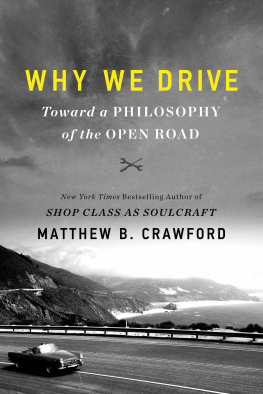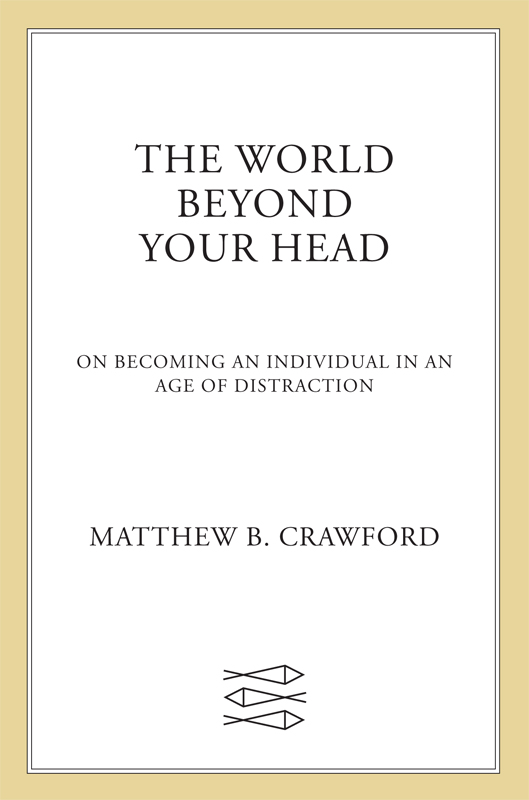Contents
Guide

The author and publisher have provided this e-book to you for your personal use only. You may not make this e-book publicly available in any way. Copyright infringement is against the law. If you believe the copy of this e-book you are reading infringes on the authors copyright, please notify the publisher at: us.macmillanusa.com/piracy.
The great thing is to gather new vigor in reality.
Vincent van Gogh
We are living through a crisis of attention that is now widely remarked upon, usually in the context of some complaint or other about technology. As our mental lives become more fragmented, what is at stake often seems to be nothing less than the question of whether one can maintain a coherent self. I mean a self that is able to act according to settled purposes and ongoing projects, rather than flitting about. Because attention is so fundamental to our mental lives, this widely felt problem presents a rare occasion when an entire society is compelled to ask anew a very old question: What does it mean to be human?
Such a reconsideration has been made necessary by profound cultural changes. I find that these changes have a certain coherence to them, an arcone that begins in the Enlightenment, accelerates in the twentieth century, and is perhaps culminating now. Though digital technologies certainly contribute to it, our current crisis of attention is the coming to fruition of a picture of the human being that was offered some centuries ago. This picture is so pervasive that it is difficult to make an object of scrutiny. At the center of it is a certain understanding of how a person encounters the world beyond his or her head.
We are said to do so only through our mental representations of the world. Life then imitates theory: Ours is now a highly mediated existence in which, sure enough, we increasingly encounter the world through representations. These are manufactured for us. Human experience has become a highly engineered and therefore manipulable thing.
My efforts to understand the experience of attending to real objects and to other people have led me to call our founding doctrines of human cognition into question, and to investigate the pressures they put on everyday life. They do so by rendering some aspects of our own experience illegible to us. In the course of this inquiry, some of the strangeness of our culturefor example, our approach to education and the mood of our public spacescomes into focus.
Drawing on certain dissident strands of thought in the philosophical tradition, I offer what I take to be a more adequate picture of how we encounter objects and other people. My hope is that this alternative understanding can help us think clearly about our current crisis of attention, and reclaim certain possibilities of human flourishing.
The weight of this positive argument is carried by case studies of attention in various skilled practices. The point of these is not to spur the reader to fantasize about becoming a short-order cook, a motorcycle racer, or a builder of pipe organs. Rather, activities like these, which elicit complete immersion in a particular situation, reveal something about our constitution that tends to get lost in the official self-understanding of the West.
Skilled practices serve as an anchor to the world beyond ones heada point of triangulation with objects and other people who have a reality of their own. The most surprising thing to emerge in this inquiry (for me, at least) is that through such triangulation we may achieve something like individuality. For it is an achievement, especially in a mass society that speaks an idiom of individualism and thereby obscures the genuine article.
The idea of writing this book gained strength one day when I swiped my bank card to pay for groceries. I watched the screen intently, waiting for it to prompt me to do the next step. During the following seconds it became clear that some genius had realized that a person in this situation is a captive audience. During those intervals between swiping my card, confirming the amount, and entering my PIN, I was shown advertisements. The intervals themselves, which I had previously assumed were a mere artifact of the communication technology, now seemed to be something more deliberately calibrated. These haltings now served somebodys interest.
Such intrusions are everywhere. Taking a flight recently to Chicago, I pulled down the tray from the seat back in front of me and discovered that the entire tray top was devoted to an advertisement for Droid, the multimedia smartphone. At OHare International Airport, the moving handrail on the escalator was covered with an endlessly recurring message from the Lincoln Financial Group: Youre In Charge. When I got to my hotel, I was handed a key card that was printed on one side with an advertisement for Benihana, the restaurant. Somehow, the fact that such a key card presents about five square inches for inevitable eyeballing had gone unnoticed, or rather unmonetized, until recently. Capitalism has gotten hip to the fact that for all our talk of an information economy, what we really have is an attentional economy, if the term economy applies to what is scarce and therefore valuable. As these last examples illustrate, the pertinent development here is a social technology, not something electronic. Turning unavoidable public surfaces into sites of marketing isnt inherently digital.
We have developed methods for tuning out commercial messages, for example by inserting earbuds or burying our faces in our devices. Bus riders in Seoul, South Korea, find themselves at a new frontier: they have advertising squirted into their noses. A smell resembling that of Dunkin Donuts coffee is released into the ventilation system as a Dunkin Donuts advertisement plays over the buss sound system shortly before the bus stops outside a Dunkin Donuts store. An announcer points out the fact, in case it has somehow been missed. This kind of advertising is especially aggressive and indiscriminate, yet is also exquisitely well targeted to morning commuters who are primed to want coffee at the time they are exposed to the advertising, and there it is, right next to the bus stop! The advertising agency responsible was rewarded by its peers with a Bronze Lion award for best use of ambient media.
There remain many areas for further progress. The homework, report cards, permissions slips, and other minor communications that a teacher sends home with students are in many school districts still blank on the back. Here is a gross offense against the efficient use of space. One forward-thinking school district in Peabody, Massachusetts, now sells advertising space on the backs of these slips of paper.
But intrusive advertising is just the tip of a larger cultural iceberg; some of the positive attractions of our attentional environment are no less troubling than the unwanted aspects. Its hard to open a newspaper or magazine these days without reading a complaint about our fractured mental lives, diminished attention spans, and a widespread sense of distraction. Often the occasion for such a story is some new neuroscience finding about how our brains are being rewired by our habits of information grazing and electronic stimulation. Though it is in the first place a faculty of individual minds, it is clear that attention has also become an acute collective problem of modern lifea cultural problem.
Our susceptibility to being buffeted by various claims on our attention is surely tied to the intensification of nervous stimulation that the German sociologist Georg Simmel identified with the metropolitan environment over a hundred years ago. Think of the corporate manager who gets two hundred emails per day and spends his time responding pell-mell to an incoherent press of demands. The way we experience this, often, is as a crisis of self-ownership: our attention isnt simply ours to direct where we will, and we complain about it bitterly. Yet this same person may find himself checking his email frequently once he gets home or while on vacation. It becomes effortful for him to be fully present while giving his children a bath or taking a meal with his spouse. Our changing technological environment generates a need for ever more stimulation. The content of the stimulation almost becomes irrelevant. Our distractibility seems to indicate that we are agnostic on the question of what is worth paying attention tothat is, what to value.









![Chris Crawford [Chris Crawford] - Chris Crawford on Game Design](/uploads/posts/book/119438/thumbs/chris-crawford-chris-crawford-chris-crawford-on.jpg)


